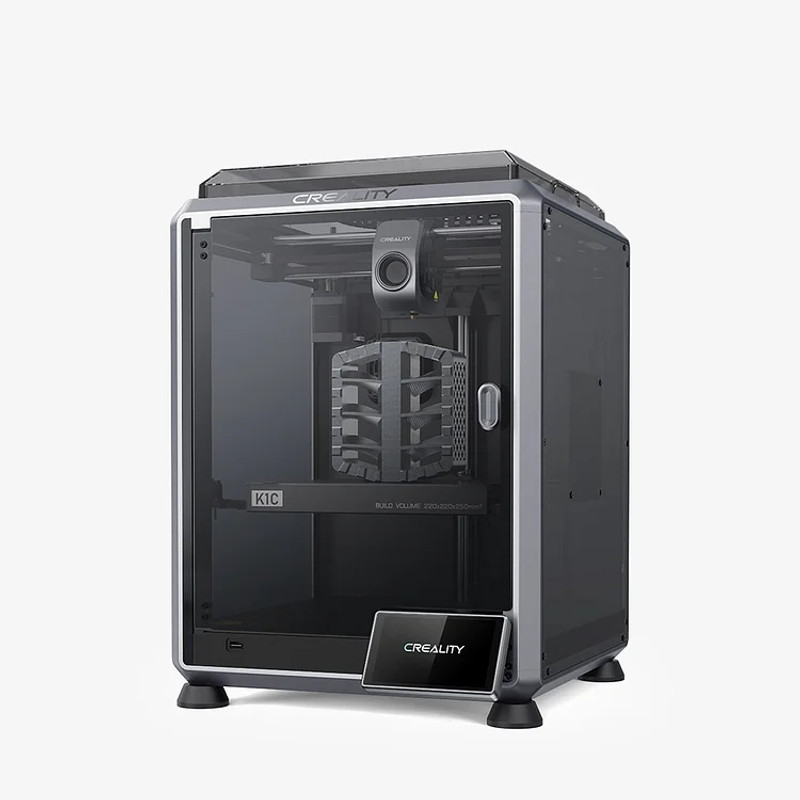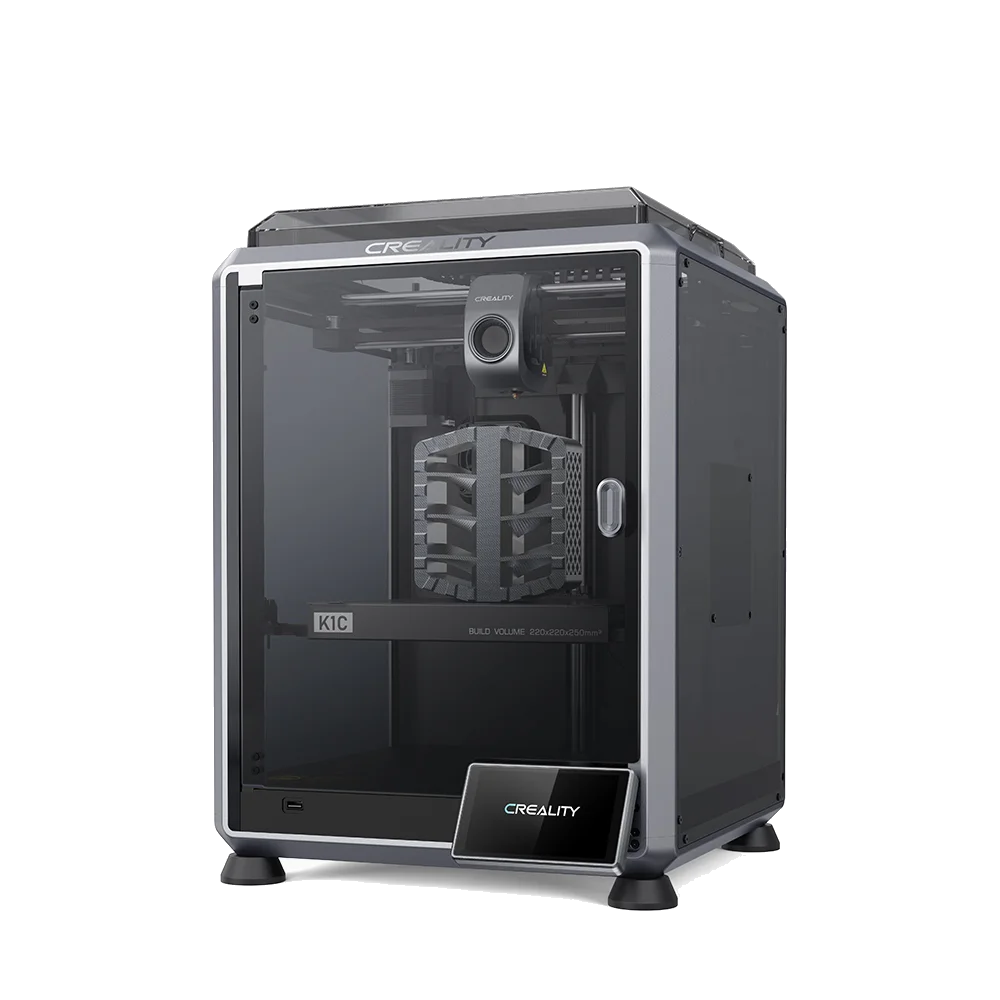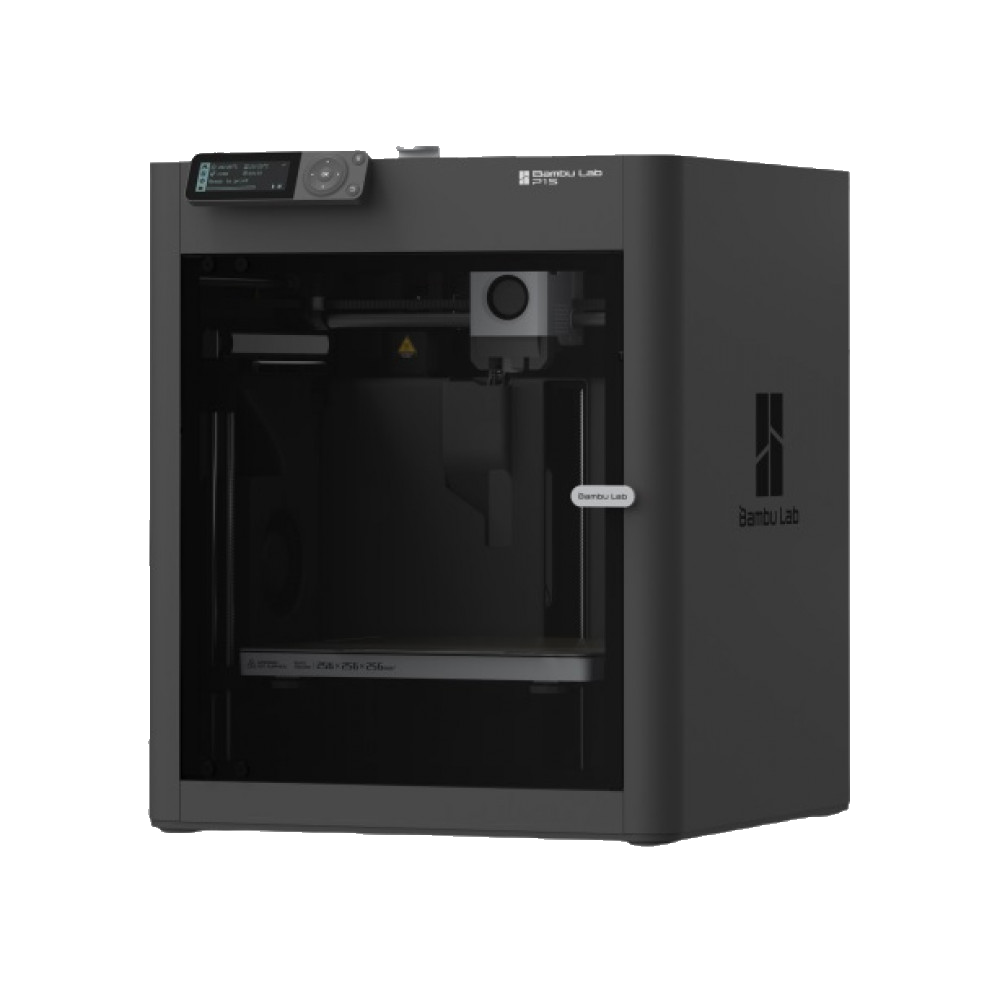If you make a purchase using a shopping link on our site, we may earn a commission. Learn More
Top pick

Creality K1C
About the Creality K1C
The Creality K1C was released early in 2024 as an upgraded version of the K1, taking many of the issues users had with the original model and addressing them with this updated machine. These updates, along with only a slight price increase, make the K1C a very compelling choice at a very competitive price point in the market of high-speed CoreXY 3D printing, especially when you consider the range of material types that the K1C is capable of printing.
Key Features of the Creality K1C
Physical Design and Motion System
The K1C looks and functions very similarly to the original K1, which took inspiration from the Bambu Lab lineup of 3D printers. The motion system is a CoreXY design, moving the print head along the X and Y axes while the print bed is moved along the Z-axis. This allows for more speed and stability while printing and is quickly becoming the preferred motion system for high-end machines moving forward. Linear rods are used to keep the motion system sturdy and lend to the durability of the machine.

This motion system is kept safe inside the K1C’s enclosure, which allows for a consistent ambient temperature when printing materials such as ABA or ASA, materials that don’t perform well on open-air frames. The included carbon-activated air filter makes this machine capable of printing a wider range of materials that would normally create harmful or unpleasant fumes when printing.
The K1C takes on an appliance-like appearance, with no wires or moving parts visible from outside of the chamber.

Hotend and Extruder
The K1C has an all-metal direct-drive extruder that uses a dual-gear system to tightly grip filament and provide consistent material flow, which is great for printing with flexible filaments. The hot end is capable of reaching temperatures of 300°C, making it compatible with all of the hobby-grade materials including PLA, PETG, and TPU, along with engineering-grade materials such as polycarbonate and carbon fiber blends.

Print Speed, Quality, and Cooling
The K1C is rated for a maximum print speed of 600 mm/s, among the fastest of its kind today. This will result in faster print times, especially when printing multiple parts at once. This type of motion system is one of the most efficient when it comes to print speed and part quality, as the stability of the print bed reduces wobbling while the print head is free to accelerate at high speeds. The use of Creality OS, Creality’s in-house open-source Klipper variant, provides improvements to speed and quality for this machine.
You can expect high-quality prints from this machine with excellent cooling capabilities. You will want to slow down your print speed to about 250-300 mm/s in order to get the optimal quality-to-speed ratio for this machine.
The large chamber cooling fan provides additional part cooling when printing at high speeds, blasting the printed part with cool air for improved overhangs and print consistency.

Automatic Bed Leveling
The Creality K1C uses a variety of smart sensors, including strain gauges and load cells, to automatically probe the print bed and create a mesh that is used to automatically adjust Z-height during printing for even printing across the bed. The Z-offset is automatically set for you, meaning you won’t have to adjust anything manually when working with this machine. This has become standard for printers in this price range.
Print Bed Surface
The Creality K1C comes stock with a textured PEI print surface. This print surface provides exceptional adhesion with no additional adhesive required. Minimal cleaning is needed to keep performance consistent. This has quickly become one of our favorite materials and is becoming standard for many of today’s 3D printers.
Build Volume
The Creality K1C has a build volume of 220 x 220 x 250 mm (8.75” x 8.75” x 10”). This is standard for many of Creality’s machines and is enough build volume for the majority of prints that the average user will attempt. You may begin to feel cramped for space when attempting to print multiple parts in the same print job. We would have liked to have seen a slightly larger print volume for this machine but overall this is a fine bed size.
Connectivity, Remote Monitoring, and Controls
The K1C connects to your local WiFi network and allows you to wirelessly send print files to the machine. You will find an AI-powered camera installed on this printer, allowing you to use the Creality Connect app to monitor your prints. This AI camera is also capable of print failure detection, pausing the print, and notifying you if anything looks wrong. This is a very nice feature that can save you from wasting filament on a failed print job. The camera can also record time-lapses of your prints for you to view after they are done.

The K1C comes with a 4.3” full-color touchscreen display that you will use to conveniently control the machine. All of the menus are easily accessible with user-friendly navigation.

Ease of Assembly and Maintenance
The Creality K1C, like many CoreXY 3D printers, comes almost completely pre-assembled out of the box. Only the spool holder and screen need to be attached to the printer before you are ready to power on the machine. You should have it up and running in under five minutes.
Maintenance for this machine is simple, with regular cleaning of the linear rods and lead screws needed to maintain print consistency. Timing belts will need to be checked and adjusted should they begin to lose tension.
The Unicorn tri-metal nozzle is quick-swappable, making it very easy to change your nozzle diameter between prints or replace your nozzle should it begin to wear. Replacement parts can be found on Creality’s website, including additional nozzle sizes, print beds, Bowden tubes, and more.

Summary
The Creality K1C is a direct competitor to the Bambu Lab P1S and X1C, with features that make for a very compelling option in the high-speed 3D printing market. It is one of the fastest 3D printers around and comes with just about every convenience feature you could ask for, making it a great printer for anyone looking to get started in the 3D printing hobby. It is a user-friendly printer and that is a good choice for a low-maintenance, high-speed, convenient machine. Creality is known for the lower, competitive prices that they attach to their 3D printers. If you can look past the above-average price tag that comes with the K1C then you can expect a very capable 3D printer in choosing it.
Brand Summary: Creality
Creality is a well-known brand that offers a wide range of consumer 3D printers across all price points, from budget to higher end models. The Ender 3 is credited with originating the budget 3D printer market. While other brands now produce lower cost clones of the Ender 3, Creality remains the most established Chinese manufacturer of 3D printers. Creality uses off-the-shelf components and standardized aluminum extrusions on many of their printers to reduce costs, making their printers easy to repair and upgrade. Their official online community forums and manufacturer support are limited, but support can be found on communities on Reddit and Discord.
Pros
- Modern mainboard features
- Auto bed leveling
- Has touch screen
- Premium components
- Fully assembled
- Direct drive extruder
- Wireless printing
- All-metal hot end
- CoreXY Kinematic System
- Enclosure
- Dual gear extruder
Cons
- High price tag
Printer Comparisons
The articles below provide in depth comparisons of the Creality K1C to other similar printers on the market.
K1C vs Bambu X1C


Vs

Comparing the Bambu Lab A1 vs the Creality K1C


Vs

Ender 3 V3 vs Creality K1C


Vs

Comparing the Creality K1C vs the Bambu P1S


Vs

You can compare the Creality K1C to other 3D printers using our Compare tool.